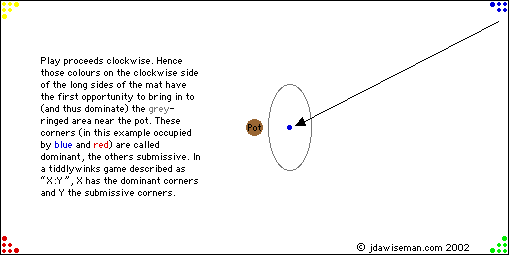Play proceeds clockwise. Hence those colours on the clockwise side of the long sides of the mat have the first opportunity to bring in to (and thus dominate) the grey-ringed area near the pot. These corners (in this example occupied by blue and red) are called dominant, the others submissive. In a tiddlywinks game described as “X:Y”, X has the dominant corners and Y the submissive corners. Likewise, in a tiddlywinks game described as “A+B:C+D”, the A-and-B team has the dominant corners, and the C-and-D team has the submissive corners. (In such an “A+B:C+D” pairs game, the player order is A then C then B then D then A, etc.)
To learn more about tiddlywinks see the Cambridge University Tiddlywinks Club, the English Tiddlywinks Association and the North American Tiddlywinks Association. Other information on the game can be found via the Wikipedia.

| Main index | Tournaments index | About author |